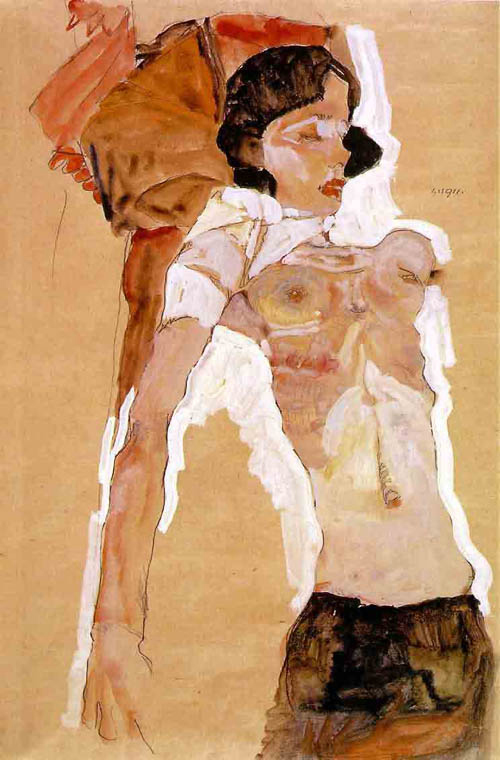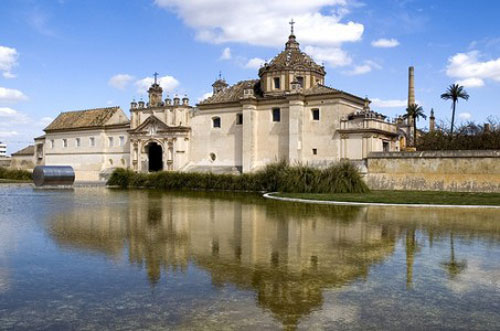End Google Tag Manager -->
Home › Archivos por

Mónica Boixeda
From time to time, in the history of art, there are characters who are difficult to classify into streams or styles, artists with an aesthetic language so intense and personal that is in some way, a stimulating mystery that delights and disturbs us, alternately and simultaneously leads us along paths of anxiety and ecstasy that we simply can’t forget. This is exactly the case of Egon Schiele (Tulln, Austria, 1890-Vienna, 1918), an artist whose life and work was full of torments and obsessions. He was rutile and fleeting star in the fascinating, modernist Vienna of the Belle Epoque period, which vanished with his death a whole world of what we call the Danube worldview. Together with Oskar Kokoschka and his mentor Gustav Klimt, who profoundly influenced his work, Schiele was one of the most outstanding artists of Viennese modernism. Although in the beginning of his career, his work was greatly influenced by Art Nouveau, soon he developed a style that combined decorative structures with the use of a broken line and aggressive fractured color, which is one of the best examples of Expressionism. His most powerful and impressive works are perhaps the portraits of nude men and women in which he expresses through their positions a variety of emotions ranging from the desperation to passion. A thrilling polarity between love and loneliness, as well as between death and life, stresses all his work. His penetrating nudes, full of a fleshless eroticism and openly exposed, somehow show an insolent and proud sadness. It is precisely his portraits and self portraits – Schiele painted himself over 150 times, and with the...

Mónica Boixeda
At the Centro Andaluz de Artes Contemporaneas (CAAC) in Seville. The exhibition “A test extending beyond the action” will soon open to everybody. This is the first retrospective exposition of K.P Brehmer who, was born in Berlin in Germany in 1938 and died in Hamburg in 1997. This fantastic exhibition will begin on the31st of May and will last until the 12th of June. At the exhibition of this German artist, one of the most important exponents of pop art, -not only in his country, but all over the world- you will be delighted with some of his most significant art pieces On the other hand, Jessica Diamond will present her exhibition called “Murales” on the exterior of the Cartuja Monastery -which is one of the CAAC headquarters- and where you will be able to view numerous piecs of her art works. This singular female artist who created her own style in the eighties, uses language to express through her paintings her countless criticisms about nowadays popular culture and generates with her art a direct energetic message filled with individuality that very little artists are capable of achieving in their life time Finally CAAC will also present the exposition “Prensadas“of Inmaculada Salinas, who, just as the previous expostion we mentioned, will have a period of visitation up until the 12th of June. Here we can see the latest art pieces of Inmaculada and can enjoy her paintings which have a more ideological content as seen in paintings like “Espejo” “Prensada” “Como Fondo” and “Visión de las vencidas“ More Info: http://www.juntadeandalucia.es/cultura/caac/programa/ex_act.htm Centro Andaluz de Artes Contemporáneo: Av. Américo Vespucio, 2...

Mónica Boixeda
All animals need a territory, which they sometimes mark with their urine. We humans do it by adorning it with our personal tastes, reflecting the way we think and view the world. We decorate our spaces with objects which mean something to us, or which make us feel loved, and cheer us up – and so if there is something that conjures up a past trauma or conflict, it is going to do the exact opposite. The founder of surrealism, Andre Breton lived in a small apartment in Pigalle – the Parisian neighbourhood famous for Moulin Rouge, cabaret and sex shops. The flat consisted of a couple of narrow rooms which were filled with paintings, curios, and magical African sculptures. Irish novelist Samuel Beckett lived in the top flat of an architecturally ordinary building, with minimal furniture, and plain blank walls. Out the window was a view of a prison wall. Marcel Marceau lived in a mansion, with a park, with trees covered in spiderwebs and walls covered with photographs of himself with famous people – actors, presidents, millionaires and so on. Most of his furniture were chests displaying medals, diplomas, trophies, etc. In a large studio, hung dozens of his posters in all different languages. Catalan architect Gaudi lived in a house full of furniture designed by himself, inside Parque Güell. He was an artist who never sought the vindication of his own ego, preferring instead to just observe nature (“The tree near my workshop is my mentor“) as inspiration for his own aesthetic style, which didn´t call for ornamentation. Gaudi was the first artist to dedicate a...

Mónica Boixeda
On at Paris´ Opera Bastille until the 7th of June, is Mozart masterpiece The Weddings of Figaro, featuring some of the best soloists in the world, with Bárbara Fritoli playing Countess Almaviva, and Ekaterina Syurina playing Susanna. The Weddings of Figaro is a great four act which was composed by Wolfgang Amadeus Mozart from the libretto by Italian poet Lorenzo da Ponte, who had been inspired by the comedy The Marriage of Figaro, by Pierre Agustín Caron de Beaumarchais. Mozart met da Ponte in the house of his first child´s godfather, the Baron of Wetzlar, and they started to put Beaumarchais´ satirical work to music. Da Ponte was an adventurer born in Venice, who had abandoned his religious upbringing to devote himself to literature, going on to hold the post of court playwright. His career working in the court hadn´t brought great success, so the project of adapting Beaumarchais was his great challenge. The piece opened in Paris to a certain amount of suspicion, due to the fact it was inspired by a text written by somebody who served in the French Revolution, and who had written in a satirical style in order to reflect upon the power struggles of the decadent nobility. Emperor Jose II opposed it being shown in Vienna, one of the most eminent places for opera at the time, as he considered it a bad omen, and too risky. Mozart and Da Ponte managed to convince him to show it, on the condition they made some amendments to the libretto, making it more socially acceptable. The fifth act was quickly deleted, and five characters omitted....
Mónica Boixeda
Avogaria is another of the typical restaurants in the city of Venice. They´re typical because there isn´t a tourist who doesn´t go there even if it´s for breakfast. The service that they give is extraordinary and because it´s in Dorsoduro, it´s in everyone´s way. Located very close to Campo San Barnaba, this restaurant has its doors open every day and it offers us complete breakfasts and at a low price. And if at midday you´re hungry because you walked a lot past all the monuments of the city, they´re also waiting for you in Avogaria with a light lunch so that you can still carry on walking the city. At mid-afternoon they offer tea and the snacks are the favourites of all tourists. And lastly, the romantic dinner in this restaurant is the best. The chef specialities are many but, what stands out the most, are their brilliantly prepared meats, pasta and desserts. The cellar of this restaurant is known in the entire city because it offers quality, variety and good price. You too have to visit this restaurant and many others in this beautiful city of canals. For that, rent apartments in Venice and live like an Italian for a few...






 English
English Français
Français Deutsch
Deutsch Italiano
Italiano Español
Español